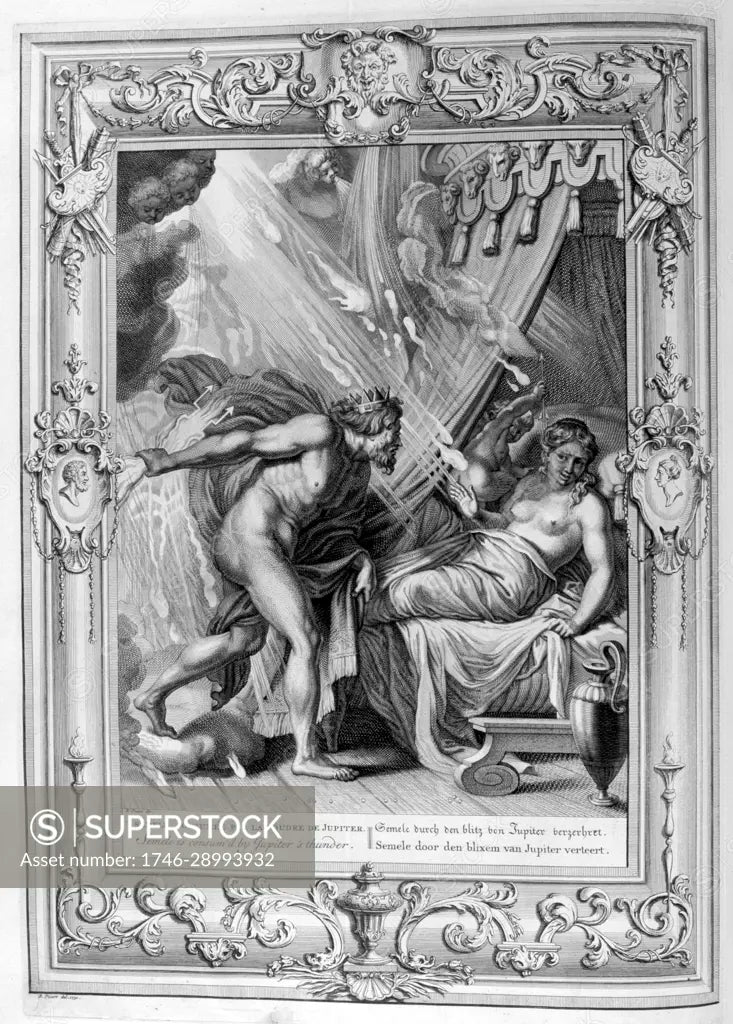ANTONIO RAIMO GALLERY
Picart, Mythology, Temple of Muses, Semele
Picart, Mythology, Temple of Muses, Semele
Couldn't load pickup availability
Bernard Picart’s *Cérémonies et coutumes religieuses de tous les peuples du monde* includes intricate illustrations of classical myths, including the tragic story of **Semele**. This mythological narrative is known for its dramatic elements and its exploration of divine interaction with mortals. Here's an overview of the story of Semele and how Picart might have depicted it within the context of the **Temple of the Muses**:
### **Semele in Mythology**
- **Background:**
- **Semele:** Semele is a mortal woman who becomes the lover of Zeus, the king of the gods. She is known for her tragic fate, which stems from her desire to see Zeus in his divine glory.
- **The Request:** Encouraged by Hera, Zeus's jealous wife, Semele demands that Zeus reveal his true form to her. Despite Zeus's warnings that his divine appearance would be overwhelming, Semele insists.
- **The Tragic Outcome:**
- **Divine Reveal:** When Zeus reveals himself in his full divine splendor, the sight is too much for Semele to bear. She is consumed by the divine fire and perishes as a result of this encounter.
- **Aftermath:** Zeus, grieving over Semele’s death, manages to save their unborn child, Dionysus. He sews Dionysus into his own thigh, and the god is later born from there.
- **Symbolism:**
- **Divine Power and Mortality:** Semele’s story highlights the theme of the dangerous nature of divine power when encountered by mortals. It reflects the limits of human understanding and the perils of exposing oneself to the overwhelming might of the gods.
- **Jealousy and Manipulation:** The myth also illustrates themes of divine jealousy and manipulation, particularly through Hera’s influence over Semele’s fate.
### **Picart’s Depiction of Semele**
- **Artistic Representation:**
- **Temple of the Muses:** In Picart’s illustrations, Semele’s story might be depicted within the context of the Temple of the Muses. This setting, dedicated to the goddesses of art and inspiration, would serve as an appropriate backdrop for the dramatic and symbolic elements of the myth.
- **Visual Elements:** Picart’s depiction would likely include the moment of Semele’s demise, showing her being consumed by divine fire. The scene might also incorporate Zeus in his divine form, emphasizing the contrast between the mortal Semele and the overwhelming power of the god.
- **Artistic Style:**
- **Detail and Accuracy:** Picart’s engravings are known for their detailed and accurate portrayal of mythological subjects. His illustration of Semele would capture the intensity and tragedy of the moment, with careful attention to the divine fire and Semele’s reaction.
- **Symbolic Imagery:** The illustration would include symbolic elements such as the divine fire that consumes Semele, Zeus’s divine presence, and possibly the depiction of Dionysus, highlighting the aftermath of the myth.
### **Artistic and Historical Context**
- **Influence:** Picart’s work significantly influenced the 18th-century understanding and depiction of classical mythology. His detailed illustrations helped shape contemporary interpretations of mythological themes and stories.
- **Educational Value:** The depiction of Semele’s story within the context of the Temple of the Muses offers insights into how classical myths were visualized and interpreted during Picart’s time. His work provides a detailed visual record of the artistic and symbolic representation of these narratives.
### **Summary**
Bernard Picart’s illustration of **Semele** within the **Temple of the Muses** presents a dramatic and detailed portrayal of this tragic mythological narrative. The story of Semele, with its themes of divine power, mortal fragility, and the consequences of divine revelation, is depicted with intense visual and symbolic elements. Picart’s work captures the essence of the myth, reflecting both its artistic and moral dimensions. Through his detailed engravings, Picart provides a valuable visual representation of classical mythology, contributing to the understanding and appreciation of these enduring stories.

-
Shipping
Share the details of your shipping policy.
-
Returns
Share the details of your return policy.
Image with text
Pair text with an image
Pair text with an image to focus on your chosen product, collection, or artist. Add details on availability, style, or even provide a review.
Image with text
Pair text with an image to provide extra information about your brand or collections.

